View in other NatureServe Network Field Guides
NatureServe
Montana
Utah
Wyoming
Idaho
Wisconsin
British Columbia
South Carolina
Yukon
California
New York
Pahaska Skipper - Hesperia pahaska
Native Species
Global Rank:
G5
State Rank:
S5
Agency Status
USFWS:
USFS:
BLM:
External Links
General Description
[From Ferris and Brown 1981; Scott 1986; Layberry et al. 1998; Opler and Wright 1999; Glassberg 2001] Forewing 1.5-1.6 cm. Uppersurface yellow-orange with broad dark-gray borders, male forewing stigma black with yellow interior felt; undersurface of hindwing orange-brown with white bar at base of discal cell, white postmedian spots (6) usually in a complete chevron, posterior arm of 4 spots straight and more or less parallel to wing margin.
Phenology
One flight, mostly mid-June to early July in the north (late June through July at high elevation); several flights in the south, mid-April to mid-October (Scott 1986). May through July in one brood areas, Aril to October in two brood areas (Glassberg 2001), June to early July in Canada (Layberry et al. 1998), late May through July in the Rocky Mountain states (Ferris and Brown 1981), early June to mid-August in Colorado (Scott and Scott 1978), April to November in Arizona (Bailowitz 1988), late June to late August in western Nebraska (Johnson and Nixon 1967), early June to late July in North Dakota (McCabe and Post 1976).
Diagnostic Characteristics
Best determined by a combination of uppersurface with dark gray rather than blackish border, male forewing stigma black with yellow interior felt, undersurface of hindwing with white bar at base of discal cell, white postmedian spots (6) usually in a complete chevron, posterior arm of 4 spots straight and more or less parallel to wing margin.
Species Range
Montana Range
Range Descriptions
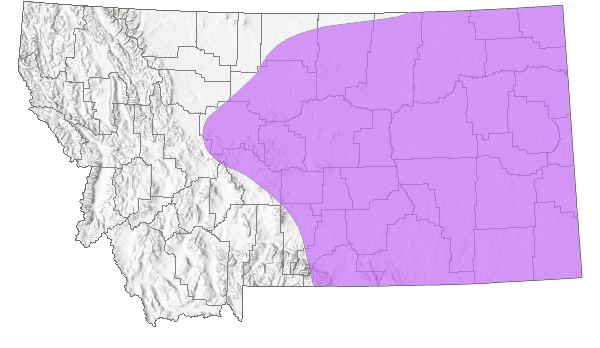
 Native
Native
Range Comments
Central Montana, southern Saskatchewan, southwestern Manitoba south to western Texas and central Mexico, west to southeastern California (Scott 1986; Layberry et al. 1998; Opler and Wright 1999; Glassberg 2001); 1350 m to 2950 m elevation in the Rocky Mountain states (Ferris and Brown 1981), 1709 m to 2926 m elevation (usually < 2743 m) in Colorado (Brown 1957; Scott and Scott 1978). In Montana, reported from at least 24 counties across the eastern 2/3 of the state, as far west as Glacier County in the north, Silver Bow County in the south (Kohler 1980; Stanford and Opler 1993; FLMNH Lepidopteristis' Society database), to at least 1830 m elevation. Mainly uncommon to common (Glassberg 2001).
Observations in Montana Natural Heritage Program Database
Number of Observations: 1
(Click on the following maps and charts to see full sized version)
Map Help and Descriptions
Relative Density
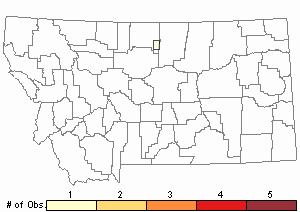
Recency
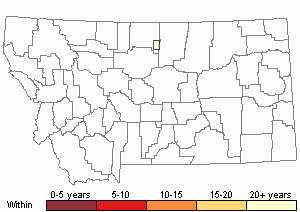
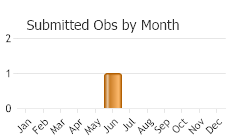
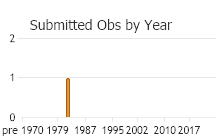
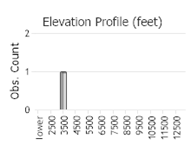 (Observations spanning multiple months or years are excluded from time charts)
(Observations spanning multiple months or years are excluded from time charts)
Migration
Non-migratory. Typically move about 200 m as adult, perhaps as much as 1000 m (Scott 1973, 1975c, 1986; Bock et al. 2007).
Habitat
Foothill prairie, desert grassland, oak grassland, open pine woodland (Ferris and Brown 1981; Scott 1986; Bailowitz 1988; Layberry et al. 1998; Opler and Wright 1999; Glassberg 2001); a Pleistocene relict in formerly-extensive montane coniferous forest on the Northern Great Plains (Johnson 1975). Habitat in Montana not described but probably similar.
Food Habits
Larval food plants are grasses, including Bouteloua gracilus and Erioneuron pulchellum (Scott 1973, 1986, 1992; Ferris and Brown 1981; Layberry et al. 1998). Adults feed on flower nectar (including Asclepias, Astragalus, Baccharis, Carduus, Cirsium, Cleome, Cryptantha, Descurainia, Erigeron, Eriogonum, Erysimum, Hedysarum, Heterotheca, Hymenopappus, Jamesia, Leucelene, Linaria, Machaeranthera, Melilotus, Mirabilis, Monarda, Opuntia, Oxytropis, Penstemon, Polygonum, Sedum, Senecio, Symphoricarpos, Symphyotrichum, Thamnosma, Thermopsis, Trifolium, Zinnia) and mud (Scott 1973, 2014).
Reproductive Characteristics
Limited information. Adult lifespan typically less than 7 days, but up to 10 days. Females lay eggs singly on undersurface of host plant leaf or near host plant. Larvae build silk-tied leaf-tube nests, feed on host plant leaves, hibernate as half-grown (L3 or L4 instar?) larvae (Scott 1973, 1979, 1986, 1992). Males perch on rocks and low plants throughout the day on hilltops and ridge crests awaiting passing females (Scott 1973, 1975b, 1986).
Stewardship Responsibility
References
- Literature Cited AboveLegend:
 View Online Publication
View Online Publication Bailowitz, R.A. 1988. Census of the butterflies of the National Audubon Society Appleton-Whittell Research Ranch, Elgin, AZ. Journal of Research on the Lepidoptera. 27:120-128.
Bailowitz, R.A. 1988. Census of the butterflies of the National Audubon Society Appleton-Whittell Research Ranch, Elgin, AZ. Journal of Research on the Lepidoptera. 27:120-128. Bock, C.E.;R.A. Bailowitz; D.W. Danforth; Z.F. Jones; and J.H. Bock. 2007. Butterflies and exurban development in southeastern Arizona. Landscape and Urban Planning. 80:34-44.
Bock, C.E.;R.A. Bailowitz; D.W. Danforth; Z.F. Jones; and J.H. Bock. 2007. Butterflies and exurban development in southeastern Arizona. Landscape and Urban Planning. 80:34-44. Glassberg, J. 2001. Butterflies through Binoculars: A Field Guide to the Butterflies of Western North America. Oxford University Press.
Glassberg, J. 2001. Butterflies through Binoculars: A Field Guide to the Butterflies of Western North America. Oxford University Press. Johnson, K. 1975. Post-Pleistocene environments and montane butterfly relicts on the western Great Plains. Journal of Research on the Lepidoptera 14(4): 216-232.
Johnson, K. 1975. Post-Pleistocene environments and montane butterfly relicts on the western Great Plains. Journal of Research on the Lepidoptera 14(4): 216-232. Johnson, K. and E. S. Nixon. 1967. The Rhopalocera of northwestern Nebraska. American Midland Naturalist 78:508-528.
Johnson, K. and E. S. Nixon. 1967. The Rhopalocera of northwestern Nebraska. American Midland Naturalist 78:508-528. McCabe, T.L. and R.L. Post. 1976. North Dakota butterfly calendar (including possible strays). Journal of Research on the Lepidoptera 15:93-99.
McCabe, T.L. and R.L. Post. 1976. North Dakota butterfly calendar (including possible strays). Journal of Research on the Lepidoptera 15:93-99. Scott, J.A. 1973c. Adult behavior and population biology of two skippers (Hesperiidea) mating in contrasting topographic sites. Journal of Research on the Lepidoptera. 12:181-196.
Scott, J.A. 1973c. Adult behavior and population biology of two skippers (Hesperiidea) mating in contrasting topographic sites. Journal of Research on the Lepidoptera. 12:181-196. Scott, J.A. 1975b. Mate-locating behavior of western North American butterflies. Journal of Research on the Lepidoptera 14:1-40.
Scott, J.A. 1975b. Mate-locating behavior of western North American butterflies. Journal of Research on the Lepidoptera 14:1-40. Scott, J.A. 1975c. Flight patterns among eleven species of diurnal Lepidoptera. Ecology 56(6): 1367-1377.
Scott, J.A. 1975c. Flight patterns among eleven species of diurnal Lepidoptera. Ecology 56(6): 1367-1377. Scott, J.A. 1979. Hibernal diapause of North American Papilionoidea and Hesperioidea. Journal of Research on the Lepidoptera 18(3): 171-200.
Scott, J.A. 1979. Hibernal diapause of North American Papilionoidea and Hesperioidea. Journal of Research on the Lepidoptera 18(3): 171-200. Scott, J.A. 1992. Hostplant records for butterflies and skippers (mostly from Colorado) 1959-1992, with new life histories and notes on oviposition, immatures, and ecology. Papilio new series #6. 185 p.
Scott, J.A. 1992. Hostplant records for butterflies and skippers (mostly from Colorado) 1959-1992, with new life histories and notes on oviposition, immatures, and ecology. Papilio new series #6. 185 p. Scott, J.A. 2014. Lepidoptera of North America 13. Flower visitation by Colorado butterflies (40,615 records) with a review of the literature on pollination of Colorado plants and butterfly attraction (Lepidoptera: Hersperioidea and Papilionoidea). Contributions of the C.P. Gillette Museum of Arthopod Diversity. Fort Collins, CO: Colorado State University. 190 p.
Scott, J.A. 2014. Lepidoptera of North America 13. Flower visitation by Colorado butterflies (40,615 records) with a review of the literature on pollination of Colorado plants and butterfly attraction (Lepidoptera: Hersperioidea and Papilionoidea). Contributions of the C.P. Gillette Museum of Arthopod Diversity. Fort Collins, CO: Colorado State University. 190 p. Scott, J.A. and G.R. Scott. 1978. Ecology and distribution of the butterflies of southern central Colorado. Journal of Research on the Lepidoptera 17(2): 73-128.
Scott, J.A. and G.R. Scott. 1978. Ecology and distribution of the butterflies of southern central Colorado. Journal of Research on the Lepidoptera 17(2): 73-128. Stanford, R.E. and P.A. Opler. 1993. Atlas of western USA butterflies: including adjacent parts of Canada and Mexico. Unpubl. Report. Denver and Fort Collins, Colorado 275 pp.
Stanford, R.E. and P.A. Opler. 1993. Atlas of western USA butterflies: including adjacent parts of Canada and Mexico. Unpubl. Report. Denver and Fort Collins, Colorado 275 pp.
- Additional ReferencesLegend:
 View Online Publication
View Online Publication
Do you know of a citation we're missing? Allen, T.J., J.P. Brock, and J. Glassberg. 2005. Caterpillars in the field and garden: a field guide to the butterfly caterpillars of North America. Oxford University Press.
Allen, T.J., J.P. Brock, and J. Glassberg. 2005. Caterpillars in the field and garden: a field guide to the butterfly caterpillars of North America. Oxford University Press. Brock, J.P. and K. Kaufman. 2003. Kaufman Field Guide to Butterflies of North America. Houghton Mifflin Company, New York, NY 284 pp.
Brock, J.P. and K. Kaufman. 2003. Kaufman Field Guide to Butterflies of North America. Houghton Mifflin Company, New York, NY 284 pp. Forister, M.L., C.A. Halsch, C.C. Nice, J.A. Fordyce, T.E. Dilts, J.C. Oliver, K.L. Prudic, A.M. Shapiro, J.K. Wilson, J. Glassberg. 2021. Fewer butterflies seen by community scientists across the warming and drying landscapes of the American West. Science 371:1042-1045.
Forister, M.L., C.A. Halsch, C.C. Nice, J.A. Fordyce, T.E. Dilts, J.C. Oliver, K.L. Prudic, A.M. Shapiro, J.K. Wilson, J. Glassberg. 2021. Fewer butterflies seen by community scientists across the warming and drying landscapes of the American West. Science 371:1042-1045. Forister, M.L., E.M. Grames, C.A. Halsch, K.J. Burls, C.F. Carroll, K.L. Bell, J.P. Jahner, et al. 2023. Assessing risk for butterflies in the context of climate change, demographic uncertainty, and heterogeneous data sources. Ecological Monographs 93(3):e1584. https://doi.org/10.1002/ecm.1584
Forister, M.L., E.M. Grames, C.A. Halsch, K.J. Burls, C.F. Carroll, K.L. Bell, J.P. Jahner, et al. 2023. Assessing risk for butterflies in the context of climate change, demographic uncertainty, and heterogeneous data sources. Ecological Monographs 93(3):e1584. https://doi.org/10.1002/ecm.1584 Layberry, R.A., P.W. Hall, and J.D. LaFontaine. 1998. The Butterflies of Canada. University of Toronto Press. 280 pp. + color plates.
Layberry, R.A., P.W. Hall, and J.D. LaFontaine. 1998. The Butterflies of Canada. University of Toronto Press. 280 pp. + color plates.
- Web Search Engines for Articles on "Pahaska Skipper"
- Additional Sources of Information Related to "Insects"





